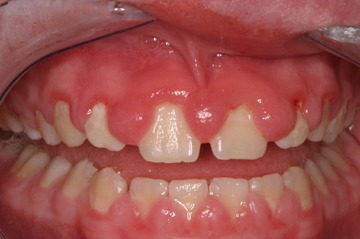Forums › Laser Treatment Tips and Techniques › Soft Tissue Procedures › dilantin hyperplasia
- This topic is empty.
-
AuthorPosts
-
jetsfanSpectator


Here is an interesting case I saw Friday afternoon. !5 yr old boy with a history of petet mal seizures since birth. Taking Dilantin 100mg tid, Phenobarb. 10 mg tid (I believe). His DDS did an exam and prophy and sent him to oral surgeon for gingevectomy. Oral surgeon took one look and said he should be seen by a laser dentist so he was referred to me. He was premedicated as a precaution by his neurosurgeon.
YOu can see his preop anterior and max, occlusal view.
Obviously this child needs quite a bit of treatment. As he was going to a school dance that evening I decided to treat the max. anterior in the limited time available to us. I used Ron ‘s DRK topical for approx 5 min. I proceeded with the Waterlase using a g6 tip at 5W 11%A. to carve away the tissue immediately around the centrals careful not to affect the enamel( which did happen in spots). As this was going very slowly and there was so much to do I upped the wattage first to 1W and eventually 1.75 w 13%A 10%w using Mark’s C3 tip to essentially festoon the fibrotic gingiva much like you would a denture wax up. He felt nothing , essentially no bleeding, no post op pain. He had a good time at the dance. He and his parents were extremely grateful.
Comments and suggestions about this and future treatment for this patient would be appreciated.Robert
SwpmnSpectatorExcellent service Robert! I can see why the patient and parents were grateful.
Kaminer’s DRK Liquid works really well and is now the only topical anesthetic we use. Many times I add a drop of methylene blue just so I can visualize exactly where the topical has been applied.
Al
jetsfanSpectatorDoing some research on lasers and epilepsy and found and article stating that non invasive laser therapy is contraindicated in epileptics(see article below). I did not realize this. Is there something that refutes this? Do I not continue with laser gingevectomies for this child?
Contraindications in Noninvasive Laser Therapy: Truth and Fiction
Author(s): Leos Navratil MD, PhD ; Jaroslava Kymplova MD, PhD
Source: Journal of Clinical Laser Medicine & Surgery Volume: 20 Number: 6 Page: 341 — 343
DOI: 10.1089/104454702320901134Abstract: Objective: Noninvasive laser therapy is a treatment method employed in many disciplines. This review article points out instances when it appears to be effective to administer such therapy. Materials and Methods: Noninvasive laser therapy has a number of suitable applications that cause minimal damage to the patient. Many patients are not sent to institutions equipped with relevant instruments, since physicians are burdened by a number of contraindications, many of which are incorrect. The purpose of this article was to divide these contraindications into the following three groups: correct indications, indications doubtful under certain conditions, and incorrect indications. Discussion: We consider the following contraindications as correct: history of a histologically demonstrated malignant carcinoma; irradiation of the neck region in hyperthyreosis; epilepsy; exposure of the retina; and exposure of the abdomen during pregnancy. The contraindications that are doubtful under certain conditions are as follows: fever and infectious diseases; certain blood diseases; heavy blood losses; neuropathies; and irradiation in the region of gonads. The other contraindications reported in the literature are considered to be in
Andrew SatlinSpectatorRobert,
I have never heard of the contraindications as stated by that article either. I am going to ask around about that.
I have treated several of these cases over the years. They are difficult. They often rebound and can be very dose dependant. You can consult the physician but rarely will they chage meds because of medication associated gingival overgrowth.
My best suggestion is to stress oral hygiene with these patients. Better plaque control is the most effective way to reduce the hyperplasia. On a fifteen year old patient you have really got your work cut out for you.
Anyway, the treatment looks very well done. Keep us posted.
Andy
jetsfanSpectatorAfter doing more research and speaking with Paul Bradley, and Mark Colonna I am convinced there is no contraindication to treating epilepsy patients with ER CR YSGG wavelength. Perhaps a case may be made for lasers in the visible spectrum being contraindicated.
Robert
-
AuthorPosts
